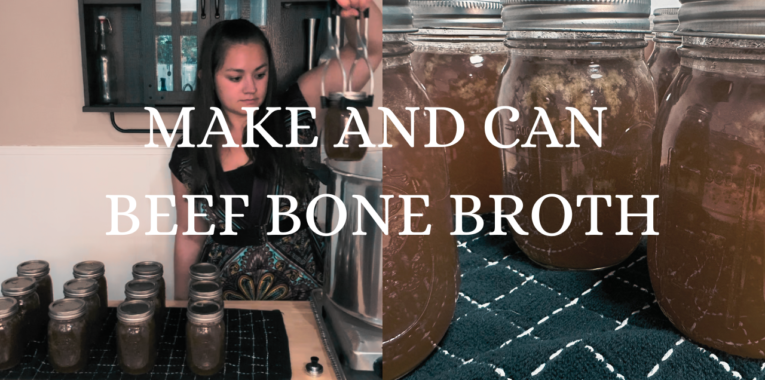Bone broth is a great way to ensure nothing goes to waste in your kitchen and, as a bonus, it’s delicious and nutritious too! Bone broth might take some time to develop that delicious, rich flavor, but its mostly hands-off time!
Waste-Free Bone Broth
Making bone broth gives you a way to use bones and veggie scraps that would otherwise be thrown away. You can use bones from the butcher, leftover from a meal, or from a rotisserie chicken!
Sam’s and Costco have $5 rotisserie chickens, and we’ll often pick one up when we’re running errands. I put the bones in a reusable freezer bag and store them in the freezer until I have enough to make broth.
For veggie scraps, I save carrot peels and tops, onion tops, bell pepper cores, and celery stalk leaves! I also store these in the freezer until I’m ready to make broth.
Bone Broth Recipe Steps
1. Roast the bones and vegetable scraps.
First, you need to roast the bones and vegetable scraps. Just put your bones and veggie scraps in a single layer on a baking tray(s) and roast at 450 degrees Fahrenheit for about an hour, turning the bones over halfway through.
You can technically skip this step, but I highly recommend taking the time to roast the bones and veggie scraps! Roasting browns the bones, which is called the Maillard reaction. I’m no scientist, but Google says this reaction “transforms proteins and sugars into complex flavors, aromas, and colors when heat and moisture are applied.”
2. Put the roasted bones and scraps in a pot to simmer.
You can use a slow cooker, a pot on the stovetop, an Instant Pot, or, my personal favorite, an electric roaster! Cover the bones and veggie scraps with water, add in 1 1/2 cups apple cider vinegar, and any aromatics you want. I usually keep it simple and only add some bay leaves and whole peppercorns.
3. Simmer as long as you want!
I love letting my broth simmer over a day. It smells delicious and I know it’s just making the final product richer and more nutritious the longer it goes!
4. Let cool slightly, then remove bones and strain the broth.
Take your broth off of the heat and leave uncovered for 1-2 hours to cool. Then, remove bones and strain the broth.
5. Cool in the refrigerator overnight or until fat solidifies on top.
Cool the broth in the refrigerator overnight or until the fat solidifies on top. Even if you can palate consuming this fat, you definitely do not want to skip this step if you’re planning on canning or freezing your broth! The fat can go rancid faster than the broth, even in the freezer, and, when canning, the lids can fail to seal if any of that fat gets under the seal.
6. Remove fat from top of broth.
Once the broth has cooled and the fat has solidified on top, remove the fat. I use a slotted spoon to scoop out the large chunks of fat and a small, fine mesh strainer to skim the little pieces of fat off the top.
7. Consume, freeze, or reheat if you’re canning the broth.
At this point, you can either drink the broth or use it to cook with. You can also freeze the broth if you have the freezer space, or reheat the broth if you’re planning on canning it!
Canning Bone Broth
If you want to can the delicious bone broth you just made to consume later, you must pressure can it. Water bath canning is reserved only for acidic foods, like most jams, jellies, and pickles, and it is not safe to water bath can non-acidic foods. I will include canning instructions below. Check out my must-have canning supplies post here!
Recipe Video
Making and Canning Bone Broth
Ingredients
Instructions
- Preheat oven to 450 degrees Fahrenheit.
- Arrange bones and vegetable scraps in a single layer on a baking tray(s).
- Roast in preheated oven for one hour, turning halfway through.
- Once bones have browned and vegetables smell aromatic, put into a stock pot, slow cooker, or electric roaster.
- Simmer for 24-36 hours.
- Remove from heat and allow to cool.
- Once cooled slightly, remove bones and strain the broth.
- Set in refrigerator overnight or until fat solidifies on top.
- Once the broth has cooled and the fat has solidified on top, remove the fat using a slotted spoon to scoop out the large chunks of fat and a small, fine mesh strainer to skim the little pieces of fat off the top.
- Consume, freeze, or reheat if you’re canning the broth.
Canning Instructions
- Reheat broth to boiling.
- While broth is reheating, prepare pressure canner according to instructions that came with your canner.
- Once broth is boiling, fill pint- or quart-sized jars, leaving 1-inch headspace.
- Apply a new, clean lid and a band fingertip tight.
- Put jar in canner.
- Once jars are filled and in the canner, put the lid on and process according to the instructions that came with your canner.
- Once pressure canner comes up to pressure, process 20 minutes for pints or 25 for quarts at 10 pounds PSI if you live at 1,000 feet or less above sea level or 15 pounds PSI if you live above 1,000 feet above sea level. For dial-gauge pressure canners, follow these instructions.
